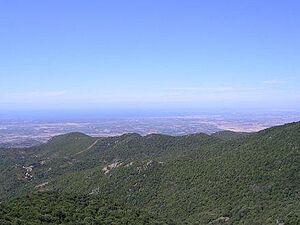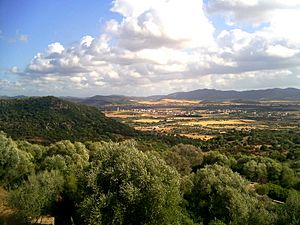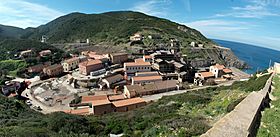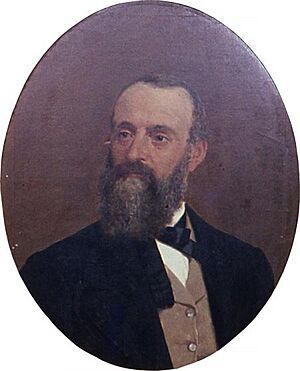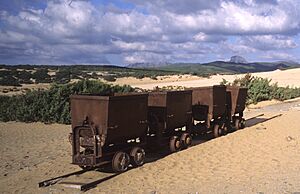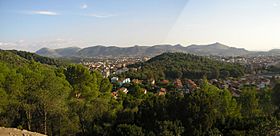History of mining in Sardinia facts for kids
Mining and processing minerals have a very long history in Sardinia. People have been digging up valuable materials from the ground for thousands of years!
Ancient traders and conquerors were very interested in Sardinia's amazing underground riches. This is why they came to the island's coast. You can still find many place names connected to mining. For example, Argentiera means "silver place." Montiferru means "iron mountain." Funtana Raminosa means "copper fountain." And Capo Ferrato means "iron cape." Even the name Gennargentu means "silver carrier." This shows how important silver mining was in the past.
Contents
Ancient Mining in Sardinia
Sardinia's long mining story likely began around 6,000 BC. People started mining obsidian on the slopes of Monte Arci. This mountain, in central-eastern Sardinia, was a major center for mining this volcanic glass. Obsidian was then sent to places like Southern France and Northern Italy.
Around 3,000 BC, people in Sardinia also started working with metal. This skill probably came from the Eastern Mediterranean Sea. They became very good at it. Extracting silver was one of the earliest metal activities in Europe. As metalworking grew, so did mining. People dug up more and more minerals to make metals.
Between 1000 BC and 800 BC, Phoenician merchants came to Sardinia. They were attracted by the island's location and its rich minerals. Later, the Carthaginians took over. Both groups heavily used Sardinia's mining wealth. Especially in the Iglesiente area, you can still see traces of their old mines and waste from melting metals. The Sarrabus region also shows signs of intense metalworking. They mined minerals containing iron sulphide, copper, and lead.
Roman Era Mining
In 238 BC, the Romans took control of Sardinia. Carthage had to give the island to Rome after losing the First Punic War. Sardinia became a Roman province in 226 BC.
Under Roman rule, mining grew a lot. They especially focused on rich deposits of lead and silver. Since 269 BC, the Roman Republic used silver for their money. Lead was used for many things, like dishes and water pipes. Sardinia became the third most important region for metal production in the Roman Empire. Only Spain and Britain produced more.
During Roman times, about 600,000 tons of lead and 1,000 tons of silver were mined. The Romans didn't just mine in Iglesiente. They also knew about and used the rich silver deposits in Sarrabus. The writer Solinus even said, "Sardinia is famous for silver."
Roman mining involved digging deep shafts, some over 100 meters deep. They used hand tools and sometimes fire-setting to break rocks. At first, miners were free workers. Later, from about 190 AD, slaves and prisoners were forced to work in the mines. In the late Roman era, mining in Sardinia slowed down a lot. Many mines were left unused and forgotten.
Middle Ages Mining
After the Western Roman Empire fell, Sardinia's history became separate from Italian Peninsula. After a short time under the Vandals, the island was ruled by the Byzantines.
During Byzantine rule, mining and metalworking started to grow again. Silver became an important product that Sardinia exported. However, around 700 AD, trade in the Mediterranean Sea became difficult. This was because of attacks by the Arabs.
Arab raids along the coast were a constant danger for Sardinia. This caused many people to leave coastal areas and move inland. Sardinia became more isolated from the Byzantine Empire. For the first time, the island gained its own self-rule. It was divided into four independent kingdoms called Giudicati. These were Cagliari, Arborea, Torres, and Gallura.
There are not many records about mining during the giudicati period. But it's likely that mining continued. In 1131, Judge Gonario II of Torres gave half of the Argentiera mine to a church in Pisa. This showed the growing ties between Sardinia and the city of Pisa.
In the early 9th century, the Italian cities of Genoa and Pisa became very involved in Sardinia. They first worked together against a Muslim leader. Later, they competed for control of the weak Sardinian kingdoms. Pisa eventually won control over most of Sardinia.
The Pisan rule brought a new boost to mining. The Pisan family of the Counts of Donoratico, especially Ugolino della Gherardesca, restarted mining in his areas. This was mainly in what is now Iglesiente.
Ugolino worked in an area called Argentaria del Sigerro, famous for its silver. He encouraged skilled Tuscan miners to move to Sardinia. He also helped found and develop the town of Villa di Chiesa, now called Iglesias.
In Iglesiente, the Pisans reopened old Roman mines and dug new shafts. The strong mining industry was guided by laws collected in a book called the Breve di Villa Chiesa. These laws had strict rules for silver mining. Stealing silver or minerals was punished severely, even with death.
Anyone in the Argentiera area could start a mining business. Often, groups of people formed companies. Miners worked 12 hours a day, from Monday noon to Saturday noon. They used picks and wedges. Sometimes, they used fire to break hard rocks. Mining stopped in summer due to the unhealthy climate and malaria.
Sardinian mines supplied Pisa with about 15 tons of silver each year from the late 12th to early 14th centuries. At its peak, the mines around Villa di Chiesa employed 6,500 workers.
Around 1326, Pisa lost its Sardinian lands to the crown of Aragon. Losing the island, especially its silver mines, was a big blow to Pisa. The Aragonese crown took control of the silver mines. This was to prevent fights among their nobles. Mining activity was much lower than under Pisan rule.
After fully conquering the island, the Aragonese tried to improve silver mining. They lowered taxes on metals. But this didn't bring back the old prosperity. Under Aragonese and later Spanish rule, mining slowly declined. Sardinia, once a major silver producer, started importing silver from the New World. However, some small local mining continued.
Under Spanish rule, mining required special permits from the government. About 40 permits were given out. Eight were for the whole island, and 18 were for the Iglesias area. Permit holders had to pay 10% of the mined mineral's value to the government. In 1622, a permit was given to explore the silver vein in Sarrabus, which had been forgotten for over 1,000 years. Spanish rule ended in Sardinia after the War of the Spanish Succession.
The Savoy Era and New Mining Methods
In 1720, Sardinia came under the rule of the House of Savoy. They became the Kings of Sardinia. The Savoy government encouraged mining again. They also gave out permits for mining across the island.
In 1740, a long-term permit was given to Charles Brander, Karl von Holtzendorf, and Karl Gustav Mandel. They had to pay a percentage of the mined lead and silver to the King. Mandel brought new technologies, like using explosives in mining. He also brought skilled German miners to Sardinia. Mandel built a large lead foundry near Villacidro. However, his permit was taken away in 1758 due to accusations of neglecting new mines and tax issues.
In 1762, Pietro De Belly took charge of Sardinian mines. He believed the government should directly exploit the mines. Belly also tried to bring back forced labor in mines. For this, he was criticized by Quintino Sella in 1771. Belly also failed to develop the rich silver vein in Sarrabus, which Mandel had seen as promising. He thought it was too expensive to mine there. The value of this region was only rediscovered much later.
The late 1700s were important for Sardinian mining. Iron was found near Arzana, and antimony near Ballao. By the early 1800s, Sardinia had 59 mines, mostly for lead, iron, copper, and silver. Many adventurers from Europe came to try their luck. Even the French writer Honoré de Balzac had a failed mining venture in 1838.
In 1840, a new mining law was passed. It separated land ownership from underground mineral rights. To mine, you needed a permit. If the landowner refused, the police chief could still allow the permit. Miners had to pay 3% of the mineral's value to the government. They also had to pay for any damage to the land. This law fully started in Sardinia in 1848. It made it easier to get mining permits. This attracted many managers and companies to the island.
In 1848, the Sardinian businessman Giovanni Antonio Sanna became the owner of the Montevecchio Mine. Located in southwest Sardinia, it was Italy's main mining site. He started modern industrial mining there. Most mining companies in Sardinia were owned by non-Sardinian investors. Giovanni Antonio Sanna was a notable exception.
Some new companies failed, while others merged to form larger, stronger companies. In 1858, Enrico Serpieri founded a lead foundry in Domusnovas. It processed lead from old waste. By 1862, his foundries produced 56% of all Sardinian lead from waste.
From 1850, skilled workers from Austria and Germany came to the Iglesiente area. They settled in mining towns like Monte Vecchio, Guspini, and Ingurtosu. You can still see some German-influenced buildings there. More miners came from mainland Italy, especially from Lombardy, Piedmont, Tuscany, and Romagna. By 1882, nearly 10,000 miners worked in southwest Sardinia. Over 3,500 were from mainland Italy.
After Italian Unification
After 1865, a new important mineral was added to lead and silver: zinc. In that year, "calamine" (zinc silicates) was found in the Malfidano mine. Around 1868, dynamite was introduced in Italy. This invention by Alfred Nobel changed mining. It made it cheaper to mine even in wet areas.
Sardinia felt uneasy within the new Italian State. In 1867, Sardinian politicians asked the Prime Minister to help reduce poverty on the island. In 1868, there was unrest in Nuoro. People protested against the sale of state-owned lands. A special commission, led by Quintino Sella, was formed to study the situation.
Sella visited the main mines and metal factories. His report showed how important Sardinian mining was to the Italian economy. In 1868-1869, Sardinian mines had over 9,000 employees. This was almost three times more than in 1860. New mining laws made it easier for companies to operate. This led to a rapid increase in mining and production.
By 1870, the number of mining permits grew from 83 to 420. Mineral extraction jumped from 9 million kilograms in 1860 to over 127 million kilograms in 1868. Its value increased five times. Sella's report also noted that mining companies built 30 kilometers of railways and 1,081 kilometers of roads. This helped transport minerals to shipping points.
The growth of mining attracted engineers and geologists from other parts of Italy. Most skilled workers also came from the mainland. This was because Sardinians had less formal education in these fields. Often, mining companies focused on exploiting the richest parts of the mines. They sent the raw materials out of Sardinia to be processed elsewhere. The large profits from Sardinian mines were not often reinvested on the island.
Sella's report highlighted the need for a school for foundry workers and mining managers in Iglesias. It also recommended investing more capital to improve mining. Building roads between mines and completing railways was crucial. The need for a good telegraph communication network was also stressed. In 1872, the main office for Sardinian mining moved from Cagliari to Iglesias.
In 1871, a new era began with the discovery of the silver-rich vein in Sarrabus. This started a new production cycle for silver in Italy. Within a short time, silver production in Sarrabus grew from 15 million tons in 1871 to 2,000 tons per year between 1880 and 1890. This period was called the "silvery ten-year span."
Many companies and individual miners searched for silver in Sarrabus. Big companies like "Unione Sulcis e Sarrabus" and "Società Tacconis-Sarrabus" were formed. At its peak, the Sarrabus area employed up to 1,500 workers. The silver ore in Sarrabus was very rich. For every 100 kilograms of lead, they found an average of 1 kilogram of silver. In some areas, like Baccu Arrodas, it was even higher.
In the 1930s, during the Fascist government, many people moved to Sardinia from mainland Italy. They came from Veneto, Marche, Abruzzo, and Sicily. They populated new mining towns in the Sulcis-Iglesiente region, like Carbonia and Cortoghiana. These towns supplied coal power plants for decades.
Today, the Geomineral Park of Sardinia helps protect the old mines and mining villages. Founded in 1989 and supported by UNESCO, these sites are now examples of industrial archeology. They show us the amazing history of mining in Sardinia.
See also
 In Spanish: Historia de la minería en Cerdeña para niños
In Spanish: Historia de la minería en Cerdeña para niños


